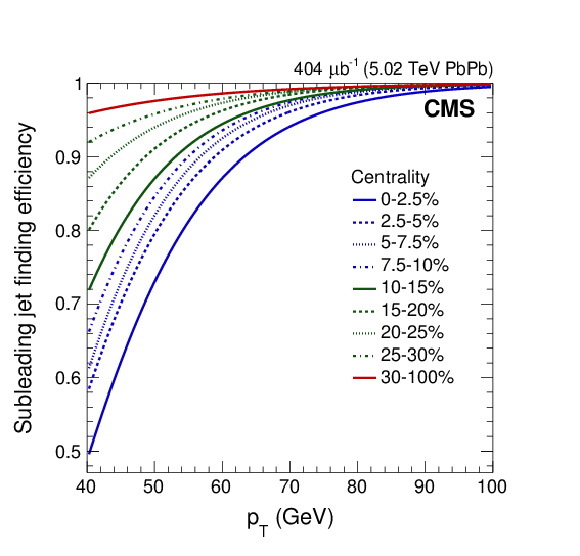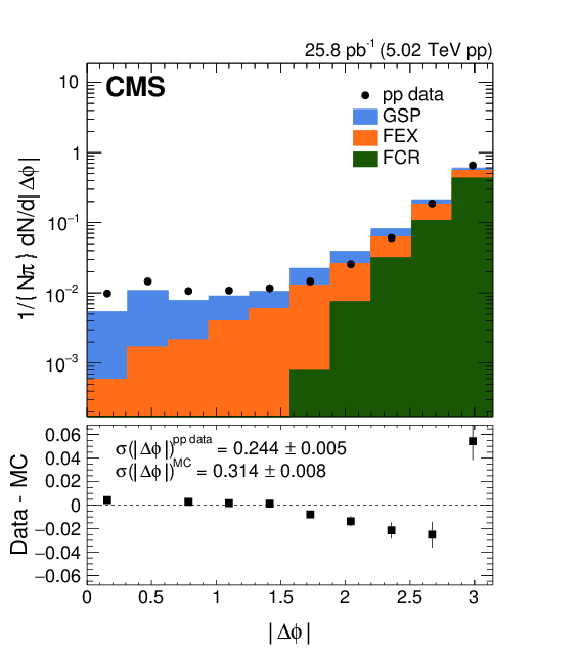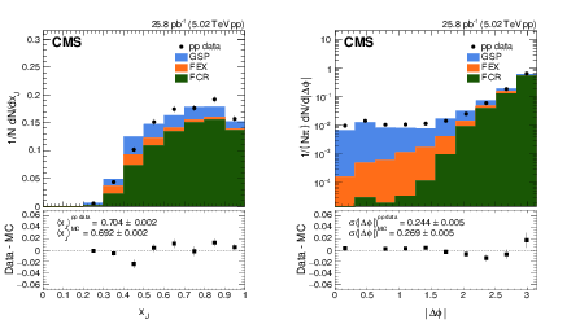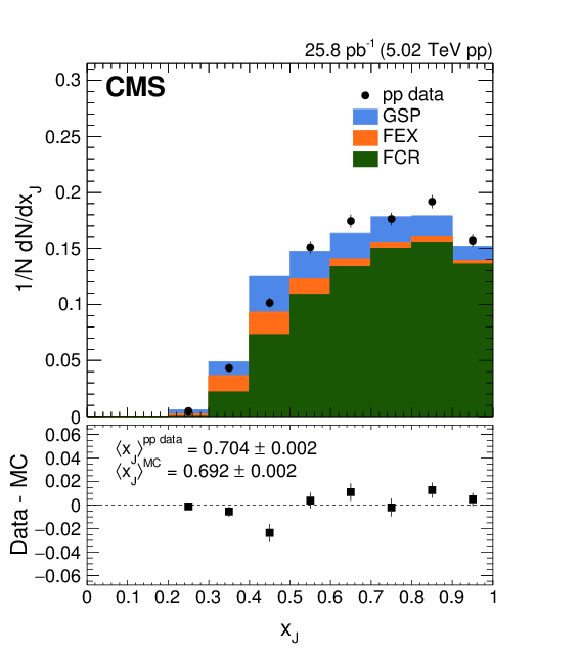

Compact Muon Solenoid
LHC, CERN
| CMS-HIN-16-005 ; CERN-EP-2018-005 | ||
| Comparing transverse momentum balance of b jet pairs in pp and PbPb collisions at ${\sqrt {\smash [b]{s_{_{\mathrm {NN}}}}}} = $ 5.02 TeV | ||
| CMS Collaboration | ||
| 2 February 2018 | ||
| JHEP 03 (2018) 181 | ||
| Abstract: The transverse momentum balance of pairs of back-to-back b quark jets in PbPb and pp collisions recorded with the CMS detector at the LHC is reported. The center-of-mass energy in both collision systems is 5.02 TeV per nucleon pair. Compared to the pp collision baseline, b quark jets have a larger imbalance in the most central PbPb collisions, as expected from the jet quenching effect. The data are also compared to the corresponding measurement with inclusive dijets. In the most central collisions, the imbalance of b quark dijets is comparable to that of inclusive dijets. | ||
| Links: e-print arXiv:1802.00707 [hep-ex] (PDF) ; CDS record ; inSPIRE record ; HepData record ; CADI line (restricted) ; | ||
| Figures | |

png pdf |
Figure 1:
The b dijet purity vs. efficiency as a function of the value of the selection on the CSV discriminator in simulation. The same CSV selection is applied to both jets. Several different centrality intervals of PbPb, as well as pp collisions, are shown, as indicated in the legend. The closed symbols indicate the working point used in this analysis. |

png pdf |
Figure 2:
Distributions of the azimuthal opening angle ($\Delta \phi$) between the leading and subleading jets for pp (left) and central (0--10%) PbPb collisions (right) for inclusive dijets and b dijets. The small-angle region ($ | {\Delta \phi} | < \pi/3$), the boundary of which is indicated by a dashed line, is used to evaluate the combinatorial contribution in PbPb collisions. The vertical bars represent statistical uncertainties, while the horizontal bars represent the bin widths. |

png pdf |
Figure 3:
The efficiency of finding a signal partner jet as function of its $ p_{\mathrm{T}} $ in PbPb collisions, as evaluated from the small-angle jet pair control region. The corrections are shown in the fine centrality bins used in the analysis. |

png pdf |
Figure 4:
Distributions of $ x_{\mathrm {J}} $ in pp collisions for inclusive dijets (left) and b dijets (right). Systematic uncertainties are shown as shaded boxes, while statistical uncertainties are shown as vertical lines. The data are compared to simulations performed using POWHEG and PYTHIA, as described in the text. |

png pdf |
Figure 5:
Distributions of $ x_{\mathrm {J}} $ in PbPb collisions for inclusive dijets (left) and b dijets (right). Systematic uncertainties are shown as shaded boxes, while statistical uncertainties are shown as vertical lines. The top, middle and bottom rows show the 0--10, 10--30 and 30--100% centrality selections, respectively. The data are compared to a reference obtained by smearing pp according to the jet resolution for the given centrality class, as described in the text. |

png pdf |
Figure 6:
$ < x_{\mathrm {J}} > $ for inclusive (left) dijets and b dijets (center) in pp collisions and for different centrality selections of PbPb collisions. The right panel shows the difference in the $ < x_{\mathrm {J}} > $ values between PbPb and the smeared pp reference. Systematic uncertainties are shown as shaded boxes, while statistical uncertainties are shown as vertical lines. |

png pdf |
Figure 7:
The distributions of $ x_{\mathrm {J}} $ (left) and $ {\Delta \phi} $ (right) in pp collisions before flavor process reweighting. Data are shown in solid points, while the stacked histograms show the contributions of different processes in PYTHIA 6 (see text for details). The bottom set of panels show the difference between data and simulation (MC). |

png pdf |
Figure 7-a:
The distribution of $ x_{\mathrm {J}} $ in pp collisions before flavor process reweighting. Data are shown in solid points, while the stacked histograms show the contributions of different processes in PYTHIA 6 (see text for details). The bottom panel shows the difference between data and simulation (MC). |

png pdf |
Figure 7-b:
The distribution of $ {\Delta \phi} $ in pp collisions before flavor process reweighting. Data are shown in solid points, while the stacked histograms show the contributions of different processes in PYTHIA 6 (see text for details). The bottom panel shows the difference between data and simulation (MC). |

png pdf |
Figure 8:
The distributions of $ x_{\mathrm {J}} $ (left) and $ {\Delta \phi} $ (right) in pp collisions after flavor process reweighting. Data are shown in solid points, while the stacked histograms show the contributions of different processes in PYTHIA 6 (see text for details). The bottom set of panels show the difference between data and simulation (MC). |

png pdf |
Figure 8-a:
The distribution of $ x_{\mathrm {J}} $ in pp collisions after flavor process reweighting. Data are shown in solid points, while the stacked histograms show the contributions of different processes in PYTHIA 6 (see text for details). The bottom panel shows the difference between data and simulation (MC). |

png pdf |
Figure 8-b:
The distribution of $ {\Delta \phi} $ in pp collisions after flavor process reweighting. Data are shown in solid points, while the stacked histograms show the contributions of different processes in PYTHIA 6 (see text for details). The bottom panel shows the difference between data and simulation (MC). |
| Tables | |

png pdf |
Table 1:
Absolute systematic uncertainties on $ < x_{\mathrm {J}} > $ for inclusive (upper sub-table) and b (lower sub-table) dijets. |

png pdf |
Table 2:
Relative contributions of the three heavy-flavor production sub-processes in PYTHIA 6 to the jet pair categories, as well as the relative abundance of the three categories in data and simulation. |

png pdf |
Table 3:
Contributions of the three production processes to selected dijets in PYTHIA 6 before and after reweighting. |
| Summary |
| In this paper, transverse momentum ($ {p_{\mathrm{T}}} $) correlations of b quark jet pairs (b dijets) have been measured in PbPb collisions for the first time, and compared to results from pp collisions. In pp collisions, a similar $ {p_{\mathrm{T}}} $ balance distribution was observed for inclusive dijets and b dijets. For the latter case, POWHEG was found to give a better description than PYTHIA 6 alone (without reweighting), suggesting that next-to-leading order effects are important for the modeling of this observable. This should be taken into consideration for models of parton energy loss in nucleus-nucleus collisions, which often use leading order calculations or generators as input. In PbPb collisions the net $ {p_{\mathrm{T}}} $ imbalance was observed to be larger in the most central collisions for b dijets, as had already been observed for inclusive dijets. This effect can be understood to originate from the energy loss of partons in the quark-gluon plasma. In the most central bin, the observed quenching effect is of comparable magnitude for b dijets and for inclusive dijets, the latter of which contains a mixture of quark and gluon jets. Insofar as parton energy loss is thought to depend on the type of parton that initiates the parton shower, this measurement can place constraints on the underlying dynamics of the interaction of the parton with the quark-gluon plasma. |
| References | ||||
| 1 | G.-Y. Qin and X.-N. Wang | Jet quenching in high-energy heavy-ion collisions | Int. J. Mod. Phys. E 24 (2015) 1530014 | 1511.00790 |
| 2 | ATLAS Collaboration | Observation of a centrality-dependent dijet asymmetry in lead-lead collisions at $ {\sqrt{\smash[b]{s_{_{\mathrm{nn}}}}}} = $ 2.76 TeV with the ATLAS detector at the LHC | PRL 105 (2010) 252303 | 1011.6182 |
| 3 | CMS Collaboration | Observation and studies of jet quenching in PbPb collisions at nucleon-nucleon center-of-mass energy = 2.76 TeV | PRC 84 (2011) 024906 | CMS-HIN-10-004 1102.1957 |
| 4 | CMS Collaboration | Measurement of transverse momentum relative to dijet systems in PbPb and pp collisions at $ {\sqrt{\smash[b]{s_{_{\mathrm{nn}}}}}} = $ 2.76 TeV | JHEP 01 (2016) 006 | CMS-HIN-14-010 1509.09029 |
| 5 | ATLAS Collaboration | Measurement of jet $ p_{\mathrm{t}} $ correlations in Pb+Pb and pp collisions at $ {\sqrt{\smash[b]{s_{_{\mathrm{nn}}}}}} = $ 2.76 TeV with the ATLAS detector | PLB 774 (2017) 379 | 1706.09363 |
| 6 | J. G. Milhano and K. C. Zapp | Origins of the di-jet asymmetry in heavy ion collisions | EPJC 76 (2016) 288 | 1512.08107 |
| 7 | Y. L. Dokshitzer and D. E. Kharzeev | Heavy quark colorimetry of QCD matter | PLB 519 (2001) 199 | hep-ph/0106202 |
| 8 | K. Zapp et al. | A Monte Carlo model for 'jet quenching' | EPJC 60 (2009) 617 | 0804.3568 |
| 9 | CMS Collaboration | Evidence of b-jet quenching in PbPb collisions at $ {\sqrt{\smash[b]{s_{_{\mathrm{nn}}}}}} = $ 2.76 TeV | PRL 113 (2014) 132301 | CMS-HIN-12-003 1312.4198 |
| 10 | CMS Collaboration | The CMS experiment at the CERN LHC | JINST 3 (2008) S08004 | CMS-00-001 |
| 11 | CMS Collaboration | The CMS trigger system | JINST 12 (2017) P01020 | CMS-TRG-12-001 1609.02366 |
| 12 | M. Cacciari, G. P. Salam, and G. Soyez | The anti-$ k_t $ jet clustering algorithm | JHEP 04 (2008) 063 | 0802.1189 |
| 13 | CMS Collaboration | Particle-flow reconstruction and global event description with the CMS detector | JINST 12 (2017) P10003 | CMS-PRF-14-001 1706.04965 |
| 14 | O. Kodolova, I. Vardanian, A. Nikitenko, and A. Oulianov | The performance of the jet identification and reconstruction in heavy ions collisions with CMS detector | EPJC 50 (2007) 117 | |
| 15 | CMS Collaboration | Determination of jet energy calibration and transverse momentum resolution in CMS | JINST 6 (2011) P11002 | CMS-JME-10-011 1107.4277 |
| 16 | CMS Collaboration | Identification of b-quark jets with the CMS experiment | JINST 8 (2013) P04013 | CMS-BTV-12-001 1211.4462 |
| 17 | CMS Collaboration | Description and performance of track and primary-vertex reconstruction with the CMS tracker | JINST (2014), no. 10, P10009 | CMS-TRK-11-001 1405.6569 |
| 18 | GEANT4 Collaboration | GEANT4---a simulation toolkit | NIMA 506 (2003) 250 | |
| 19 | T. Sjostrand, S. Mrenna, and P. Skands | PYTHIA 6.4 physics and manual | JHEP 05 (2006) 026 | hep-ph/0603175 |
| 20 | R. Field | Min-bias and the underlying event at the LHC | Acta Phys. Polon. B 42 (2011) 2631 | 1110.5530 |
| 21 | I. P. Lokhtin and A. M. Snigirev | A model of jet quenching in ultrarelativistic heavy ion collisions and high-$ p_{\rm t} $ hadron spectra at RHIC | EPJC 45 (2006) 211 | hep-ph/0506189 |
| 22 | CMS Collaboration | Jet energy scale and resolution in the CMS experiment in pp collisions at 8 TeV | JINST 12 (2017) P02014 | CMS-JME-13-004 1607.03663 |
| 23 | CMS Collaboration | Measurement of jet fragmentation into charged particles in pp and PbPb collisions at $ {\sqrt{\smash[b]{s_{_{\mathrm{nn}}}}}} = $ 2.76 TeV | JHEP 10 (2012) 087 | CMS-HIN-11-004 1205.5872 |
| 24 | CMS Collaboration | Measurement of jet fragmentation in PbPb and pp collisions at $ {\sqrt{\smash[b]{s_{_{\mathrm{nn}}}}}} = $ 2.76 TeV | PRC 90 (2014) 024908 | CMS-HIN-12-013 1406.0932 |
| 25 | CMS Collaboration | Correlations between jets and charged particles in PbPb and pp collisions at $ {\sqrt{\smash[b]{s_{_{\mathrm{nn}}}}}} = $ 2.76 TeV | JHEP 02 (2016) 156 | CMS-HIN-14-016 1601.00079 |
| 26 | S. Frixione, P. Nason, and G. Ridolfi | A positive-weight next-to-leading-order Monte Carlo for heavy flavour hadroproduction | JHEP 09 (2007) 126 | 0707.3088 |
| 27 | S. Alioli, P. Nason, C. Oleari, and E. Re | A general framework for implementing NLO calculations in shower Monte Carlo programs: the POWHEG BOX | JHEP 06 (2010) 043 | 1002.2581 |
| 28 | S. Frixione, P. Nason, and C. Oleari | Matching NLO QCD computations with parton shower simulations: the POWHEG method | JHEP 11 (2007) 070 | 0709.2092 |
| 29 | P. Nason | A new method for combining NLO QCD with shower Monte Carlo algorithms | JHEP 11 (2004) 040 | hep-ph/0409146 |
| 30 | T. Sjostrand, S. Mrenna, and P. Z. Skands | A brief introduction to PYTHIA 8.1 | CPC 178 (2008) 852 | 0710.3820 |
| 31 | CMS Collaboration | Event generator tunes obtained from underlying event and multiparton scattering measurements | EPJC 76 (2016) 155 | CMS-GEN-14-001 1512.00815 |
| 32 | M. L. Miller, K. Reygers, S. J. Sanders, and P. Steinberg | Glauber modeling in high energy nuclear collisions | Ann. Rev. Nucl. Part. Sci. 57 (2007) 205 | nucl-ex/0701025 |
| 33 | B. Alver et al. | Importance of correlations and fluctuations on the initial source eccentricity in high-energy nucleus-nucleus collisions | PRC 77 (2008) 014906 | 0711.3724 |
| 34 | CMS Collaboration | Jet momentum dependence of jet quenching in PbPb collisions at $ {\sqrt{\smash[b]{s_{_{\mathrm{nn}}}}}} = $ 2.76 TeV | PLB 712 (2012) 176 | CMS-HIN-11-013 1202.5022 |
| 35 | CDF Collaboration | Measurements of $ {\rm b\bar{b}} $ azimuthal production correlations in $ {\rm p\bar{p}} $ collisions at $ \sqrt{s} = $ 1.8 TeV | PRD 71 (2005) 092001 | hep-ex/0412006 |

|
Compact Muon Solenoid LHC, CERN |

|

|

|

|

|

|